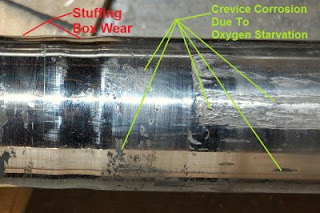Now that I have got my "house" in order (Boat shed) and reasonably set up, I am tackling my first task ... the installation of the prop shaft. The boat has a 50mm (2") stainless tube laminated during the laying up of the keel. (This helps and I do not have to go through the process of marking out and boring the keel ... not a task I would look forward too!!) There is no strut with a whip strut and cutless bearing to worry about as the design has the prop located behind the dead wood, so a simple stern bearing is all that is required
Sketch of the installation
Which method
Over the last week, I have been researching the web to find which stuffing box was the best answer and should I use a water lubricated or closed system that is grease lubricated. With some good advice from ol'mate Scott Noble and asome other advice, I have decided on a traditional self aligning shaft log and the water lubricated method. I will introduce water from the engine cooling system to keep a positive flow of water which will keep the stern bearing lubricated and cool while in use. I will use a pillow block bearing to carry at the "top" of the shaft- this will help with engine alignment and carry the trust (fwd & rev).
All of that sorted ... lets get to work ...... To be continued.
This is interesting reading ... I came across this interesting post from http://www.pbase.com/mainecruising/stuffing_box&page=2
Why It Should Drip Some
Real Tobin bronze shafting has been long gone for many years now and as such alloys in the stainless family such as Aqumet & Nitronic are now being used. These alloys, like type 304 and 316 SS can suffer from crevice corrosion. Crevice corrosion is worst when a stainless is in contact with seawater and also oxygen starved. This corrosion can happen between wet or leaking decks to chain plates or in keel stubs to the stainless keel bolts but many are unaware that it can happen to prop shafts too. Allowing the packing box to drip helps keep the water in the shaft log from becoming oxygen depleted.
Over the last 10-15 years there has been a dramatic rise in crevice corrosion of prop shafting. With the newer packing materials, and misleading advertising that use phrases like drip-less that cause DIY's to think it means "dripless" not drips less, owners have been starving the packing box area of oxygen by not allowing any fresh oxygenated water to pass through it. This can lead to the destruction of your prop shafting from crevice corrosion. While some packings such as Gore GFO, Ultra-X or GTU may be able to be adjusted to be mostly dry and still some what cool to the touch it is still a bad idea from a crevice corrosion stand point.
Another pit fall when a stuffing box is run totally sealed and "drip free" they can begin to trap air up in the shaft log. All it takes is a quick blast of reverse, and the resulting cavitation bubbles forced up and in, or after sailing in rough weather. Once enough air becomes trapped up in the shaft log the packing box you thought was cool to the touch begins cooking while you least expect it. Even PSS has now moved to selling all their drip less packing boxes with an air vent.
If a stuffing box is allowed to drip it allows for excellent cooling, longer shaft life, less opportunity for crevice corrosion and less opportunity for trapped air to run the box totally dry and cook it.
Simple Answer: I fit a traditional floating shaft log with conventional packing and allow the gentle drip. Below the log I will fabricate a contained area with a small bilge pump and a float switch .... nothing like belt and braces !!!!!




No comments:
Post a Comment